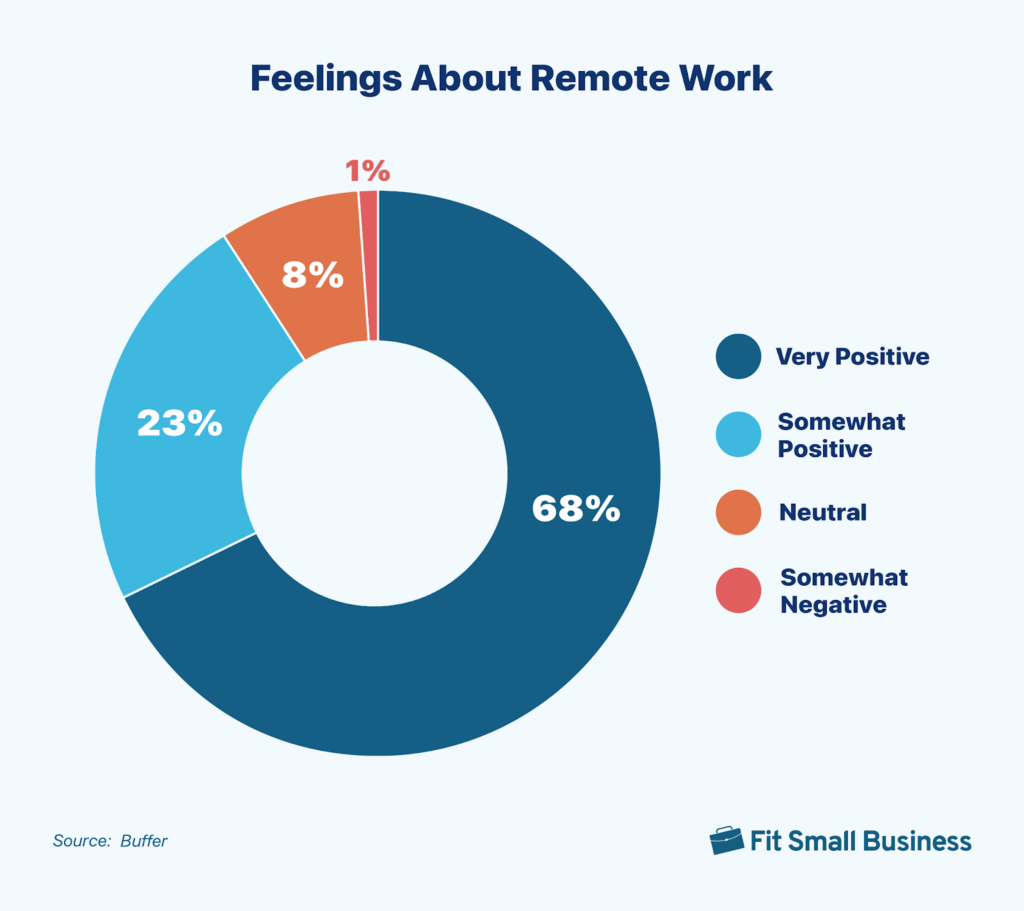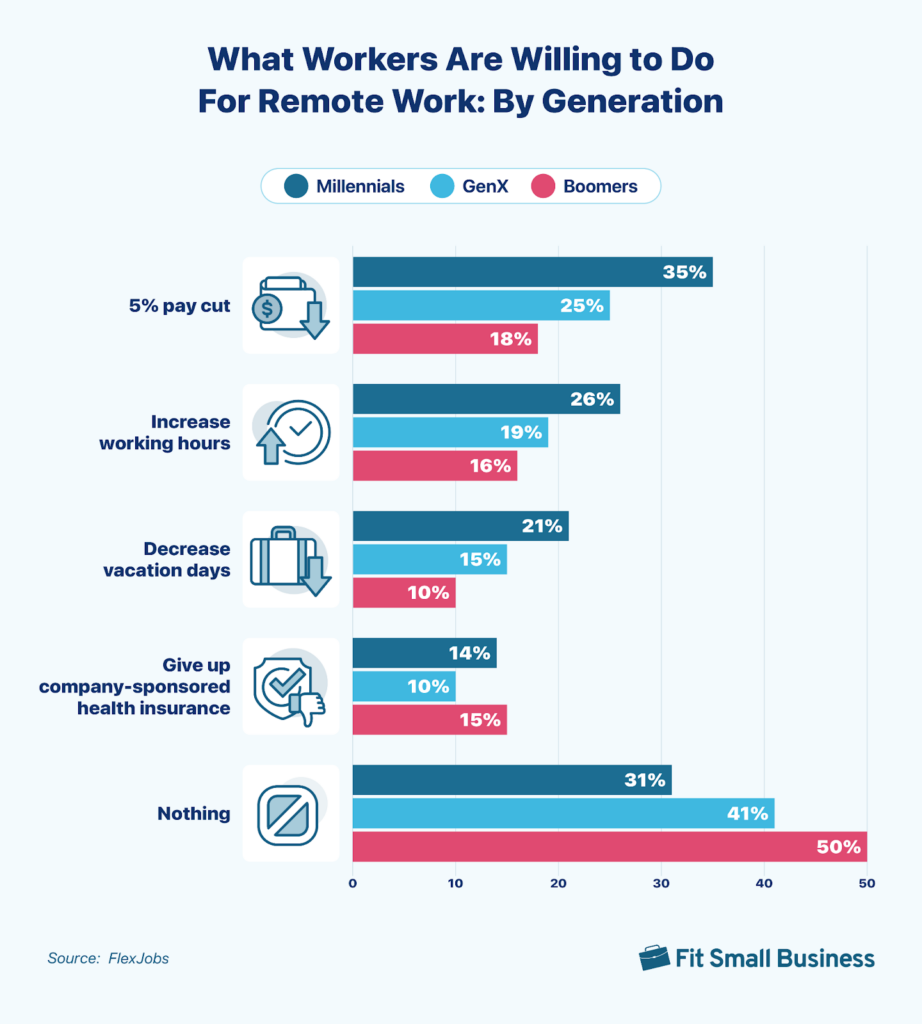Remote work statistics show dramatic changes in where and when employees are now working. Despite many experts and employers anticipating—or hoping—these trends would change post-pandemic, they haven’t. Remote work is sticking around, and workers have made it clear they don’t want to be in an office all day, every day. Using data as a guide, your small business can adapt to the changing work environment and stand out to potential employees while retaining—or increasing—your company’s productivity.
Key Takeaways:
- Job seekers say now is the time to find remote work.
- Over ⅓ of workers today work from home even when in-office options are available.
- Just 36% of remote workers are fully engaged.
- Remote work makes 84% of workers happy.
Key Workplace & Remote Work Statistics
1. Information technology companies have the highest number of remote workers
IT jobs have long been known to be able to be performed anywhere, making it the largest source of remote workers today. IT workers work an average of 2.28 days from home per week. Coming in close behind are finance and insurance at 2.22 days, professional and business services at 2.09 days, and arts and entertainment at 1.95 days.
(WFHResearch)
2. Flexible work policies are the third most important factor for job seekers
Flexible working arrangements are the third most important consideration for job seekers, behind increased pay and better opportunities. This means if a candidate is entertaining multiple job offers around the same salary, your company could win out by having a flexible work arrangement.
(McKinsey)
3. 98% of employees want to work remotely at least some of the time
Across all demographics, workers today want the option to work remotely at least part of the time. Furthermore, most workers who have worked remotely found it to be a positive experience. If they haven’t already, companies need to make dramatic workplace changes to accommodate shifting workforce demands.
(Buffer)

4. 40 million Americans will work from home by 2026
According to the survey, 40 million workers will be working from home by 2026. This study suggested that nearly 28% of workers would be fully remote by 2026. A prior Upwork survey showed that only 23% would be fully remote by 2025.
(Upwork)
5. 35% of workers today work from home, down by half from pandemic days
In 2020, 64% of employees worked from home because their office was closed. In 2023, the most recent year data is available, only 35% of workers are full-time remote, 41% work in a hybrid capacity, with 12% rarely or never working from home.
(Pew)
6. Most companies offer a hybrid work model over fully remote
Most businesses that allow work from home have adopted a hybrid workforce model, with just under 45% of workers spending their workweek both at home and in the office. A hybrid flexible schedule usually consists of one or two days per week in the office, with the rest of the time working remotely.
(WFHResearch)
Hiring Remotely
7. Job seekers say now is the time to find a job
After a huge decline in job opportunities during the pandemic, there has been a resurgence in jobs with 54% of job seekers saying now is a good time to look for a job—and what they want are remote jobs. You can make your company stand out by offering remote or hybrid opportunities.
(Gallup)
8. If given the option, 87% of workers would work remotely
When a company provides the option for workers to work remotely, 87% of survey respondents said they’d take the offer. These results are not restricted to certain industries, either. People from nearly every type of work, including typically blue-collar industries, would work remote when given the chance.
(McKinsey)
9. For remote opportunities, job seekers are willing to take a pay cut and give up vacation time
If offered the opportunity to work from anywhere, job seekers would take a pay cut (50%), increase their working hours (20%), and give up vacation days (15%). This shows that individuals who are looking for work want the flexibility to work from anywhere, and would sacrifice their salaries to do so.
(FlexJobs – Insights From FlexJobs’ 2024 Work-From-Anywhere Survey)
Remote Work by Demographics
10. Millennials are most willing to sacrifice pay and time to work remotely
In a survey of millennials, Gen X, and boomers, millennials were most willing to sacrifice traditional job requirements (like top pay, 40-hour workweeks, and robust PTO) to work a remote job. This doesn’t mean you should decrease pay for remote workers, but it means they are dedicated to finding remote opportunities.
(FlexJobs – Insights From FlexJobs’ 2024 Work-From-Anywhere Survey)

11. More than 55% of remote workers hold a bachelor’s degree or higher
Employees with advanced degrees (those with a bachelor’s degree or higher) are more likely to find and retain remote work. Remote workers tend to work with a lot of clients and customers, requiring that they have specific training that goes beyond high school.
(SelectSoftwareReviews)
12. Almost 65% of remote workers identify as white
White workers have always topped the charts as the largest in the working class, and that is no exception when it comes to remote work. In addition, close to 50% of them are male. Having a good diversity and inclusion program in place can help bridge the gap for others to find remote work. This not only leads to a more diverse workforce, but may increase productivity and employee engagement.
(SelectSoftwareReviews)
13. Depending on where an employee lives and works, they can save an average of $5,700 per year on commuting costs
The pandemic showed many workers just how much money they could save by not commuting to an office or workplace every day. In expensive cities (the LendingTree study looked at the top 100), the costs of public transportation, gas, tolls, and parking can easily reach into the thousands of dollars per year. Instead of spending this money on their job, workers can see extra savings build up, increasing their satisfaction with their job.
Workers also save time by reducing or eliminating their commute (an average of 52 minutes in the top 100 cities), giving them more focused productivity to their employer.
(Lending Tree)
Work From Home Productivity & Engagement
14. Just 36% of remote workers are fully engaged
While the engagement rate of fully remote workers may seem low, at 36%, it is higher than those who work on-site (29%). Some employees find working from home find it easier to focus, while others report better focus when working in the office. However, the flexibility of working from home creates a better work-life balance, which is highly sought after in today’s workforce.
(Gallup)
15. Low employee engagement costs the global economy $8.9 trillion
Most employees remain disengaged at work, costing the global economy $8.9 trillion. But companies have the power to change this statistic by engaging employees—and one of the best ways to do that, as noted in the stat above, is to allow work location flexibility. When employees are engaged, they are more productive workers.
(Gallup)
16. 22% of remote workers struggle with unplugging
Remote employees may be more engaged, healthier, and productive employees, but they also struggle with disconnecting. When you work from your living room or kitchen table, it’s hard to mentally disconnect. Workers need help and support from their employer or they risk sliding into a state of disengagement and withdrawing completely.
(Buffer)
Remote Work-life Balance
17. 48% of remote workers reported working longer hours than those in the office
People working remotely tend to work more hours than those working in an office. 48% said they work outside of traditional hours; regularly checking emails on weekends and while on vacation.
(Buffer)
18. Workers are more stressed than ever before
41% of workers today say they experience a lot of daily stress. When employees feel stressed, that reduces their productivity and engagement, making for a less pleasant work environment, even for remote workers.
(Gallup)
19. 84% of workers find remote work makes them happier
Mental health is increasingly something workers seek. Working remotely or from home helps them be happier. Partly because they deal with less workplace stress by not going into an office, these workers are more likely to have a better work/life balance, which makes them more productive and focused when they’re working.
(FlexJobs – Work-Life Balance or Better Pay?)
Remote Work Trends
20. Remote workers are less likely to get a raise
Between remote, hybrid, and on-site workers, remote workers are least likely to receive a promotion or get a raise. This may be due to a lack of visibility where remote workers are often overlooked. To prevent this, schedule virtual team meetings to get face-to-face time with all your workers, track KPIs to determine when an employee has reached the promotion level, and provide development opportunities.
(ResumeBuilder)

21. 6 out of 10 employers cite cost savings by going remote
While many companies do not want to go fully remote, they could save an astounding amount of money each year by having their workforce go remote for at least half of their workweek. From the lower cost of office space and less turnover to increased productivity and employee engagement, companies may see drastically reduced overhead.
(Global Workplace Analytics)
22. 1 in 3 workers would look for a new job if flexible work options were taken away
Workers want flexibility, and many have gotten it over the last couple of years. If that flexibility is taken away, 31% of workers would immediately start looking for a new job. According to the survey, 6% of workers would quit if they didn’t have the flexibility to work remotely. Hiring employees takes a great deal of time and you don’t want to continuously repeat that effort with low attrition rates.
(Pumble)
Benefits and Challenges of Remote Work
Benefits | Challenges |
|---|---|
|
|
|
|
|
|
Our Methodology
To deliver the best remote work statistics, we evaluated the top remote work surveys conducted by professionals. We gathered data from the source to bring you current stats. In our evaluation, we looked at trends in remote work, work-life balance statistics, demographics, and productivity surveys. We reviewed key remote work statistics that can help your business decide if remote work is right for you. And, we looked at hiring trends to help you when searching for new candidates.
Bottom Line
The data is clear—remote work is here to stay. Companies must embrace this changing workforce dynamic or risk being left behind as employees leave for competitors, offering the flexible work options they want. Take this information and make positive changes in your organization to stay on top of workplace and remote work trends, which can help you attract and retain top talent in your industry.
Resources: McKinsey, Buffer, Upwork, FlexJobs (Insights From FlexJobs’ 2024 Work-From-Anywhere Survey; Work-Life Balance or Better Pay?), Gallup, Global Workplace Analytics, LendingTree, Pumble, Pew, BLS, WFHResearch, ResumeBuilder, SelectSoftwareReviews